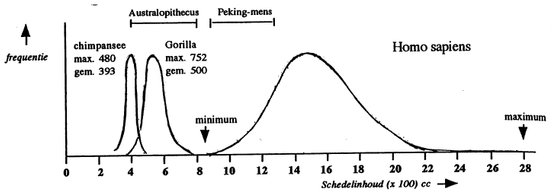KEPLER-SCIENCE
Origin of Man
Do man and apes have a common ancestor or a common creator? Science does not easily give the answer. We cannot cross fossils and we cannot be sure of their age. We can of course compare and will see that:
- Brain capacity studies suggest a gap between Apes (including Australopithecus) and Man (including the Peking-man, the Mono erectus and the Neanderthal man) - see the graph below.
- Walking upright as a normal way of going about show the same gap between the two groups (shown by a study of the semi-circular canals of the balance organ).
- A comparitive study into the build of Apes and Man shows at least ten differences that are connected to walking upright.
- Language gives a clear distinction between Apes and Man. Apes cannot build sentences. Furthermore there seems to be much evidence for the degeneration of languages in stead of evolution.
- A big question is the origin of morals and ethics - and of wars etcetera.
The Genesis model
A Genesis model suggests a migration after the Flood resulting in isolation of small populations (resulting in some gene varieties getting lost), leading to different races. Adaptations to the climate were possible because of the variety in the gene-pool: think of bigger noses and smaller skulls in the tropics and the differences in skin colour (a darker skin being a disadvantage in area's with less sunlight). Over time languages lost variety in wording and grammar, as can be shown from the comparison between dead and living languages.
What does our DNA tell us?
Mitochondrial DNA is only inherited through the female line. Studies seem to point towards a recent Eve (see link nr 1).
To what extent does the DNA of Chimpanzee match the human DNA? Widespread are percentages of 98% or more, but these are based on hybridising DNA of both organisms, but that is an old and inaccurate technique. In 2002 Britt used a more modern technique to compare DNA-sequences and arrived at 95%. The reason for this larger difference lies in indels: unique genes found only in Man or Chimpanzee. After sequencing the complete genome of Man in 2004 it became possible to really compare the genomes in detail. The first quantitative study (in 2005) showed a difference of 8,5%, with dozens of unique for protein coding genes (not to be found in the Chimpanzee). A new study in 2007 showed that the human genome contains around 1400 unique genes in total.
LINKS:
- About: mitochondrial DNA
- Read: I love Lucy
- Have humans evolved from Ape-like creatures?
- For more Dutch links go to: 'mens'
- About DNA similarities between Ape and Men (more links can be found there.
- Behaviour of chimpansees can be explained in a simple way.
- Also look at the DNA-page - especially link 1 and 2
Dating
A lot of skeletal material used in the debate about human descent is found in the Olduvai gap in Kenya. High age differences between for instance Lucy (an Australopithecus) and modern Man have been suggested, but new findings seem to contradict these differences.
Ald of these skulls (sometimes only fragments) are found in tuff stonreformed out of volcanic ashes). Chemical analysis of the different strata shows the chemial fingerprint of all these strata to be the same, which makes it very likely these strata were formed in a short time as a result of a single (series of) eruption(s) of the same volcano. Chemical fingerprints are unique and different for each eruption.




